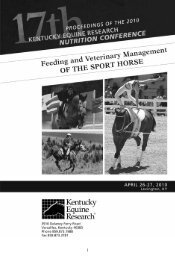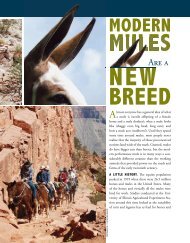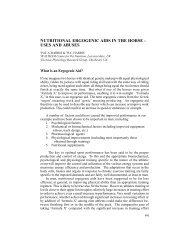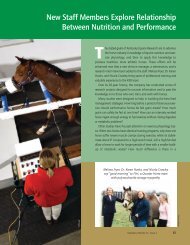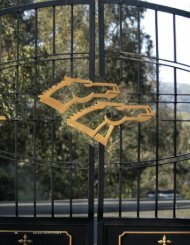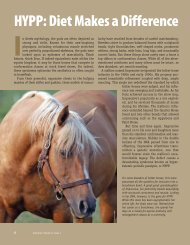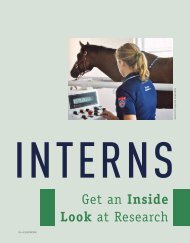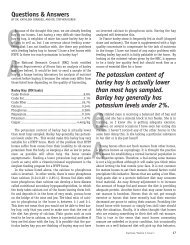When two worlds merge - Kentucky Equine Research
When two worlds merge - Kentucky Equine Research
When two worlds merge - Kentucky Equine Research
You also want an ePaper? Increase the reach of your titles
YUMPU automatically turns print PDFs into web optimized ePapers that Google loves.
<strong>Kentucky</strong> <strong>Equine</strong> <strong>Research</strong> and Academia<br />
Join Forces to Benefit Stock Horses<br />
and Thoroughbreds<br />
In the world of research, success is often the result of<br />
a team effort. Throughout its history, <strong>Kentucky</strong> <strong>Equine</strong><br />
<strong>Research</strong> (KER) has collaborated with numerous<br />
researchers throughout the world to bring the horse<br />
industry the most progressive and scientifically<br />
substantiated feeds and services. But perhaps none<br />
of these relationships has been as longstanding and<br />
fertile as the one shared with Stephanie Valberg, D.V.M.,<br />
Ph.D., of the University of Minnesota.<br />
Photos by Z<br />
©2004 Charles Hilton
Joe Pagan, Ph.D., founder and president of <strong>Kentucky</strong><br />
<strong>Equine</strong> <strong>Research</strong> (KER), first met Valberg in Sweden in the<br />
mid-1980s.<br />
Dr. Sune Persson and Arne Lindholm of the Swedish<br />
University of Agricultural Sciences invited to their<br />
Scandinavian laboratory a group of scientists interested in<br />
studying exercise physiology in Standardbred trotters. The<br />
single piece of equipment that most attracted Valberg and<br />
Pagan was, in fact, a high-speed treadmill, a monstrosity<br />
built by Saab, the Swedish airline company. ”At that time,<br />
there were no high-speed treadmills for horses in the<br />
United States, so Sweden was the mecca for people interested<br />
in equine exercise physiology,” explained Valberg.<br />
Unlike the noisy treadmills of today, the motor for that<br />
piece of equipment was housed in a separate building. A<br />
mat of woven coconut hair lined the belt and softened the<br />
blows of hooves, so little noise was produced when it was<br />
being used. Construction expenses preclude the widespread<br />
duplication of this uber-treadmill, but researchers worldwide<br />
maximized its use for several years. During their time<br />
at the Swedish University of Agricultural Sciences, Valberg<br />
completed her Ph.D. studies and Pagan finished up postdoctoral<br />
research. Eventually, each returned to the United<br />
States with a different focus.<br />
While Pagan was laying the groundwork for a fledgling<br />
company called <strong>Kentucky</strong> <strong>Equine</strong> <strong>Research</strong> in the late<br />
1980s, Valberg continued exercise physiology research. She<br />
began working under Dr. George Cardinet, a specialist in<br />
Supplied by Stephanie Valberg<br />
neuromuscular diseases of animals at the University of<br />
California in Davis. Dr. Cardinet had invited Valberg to<br />
California with the expectation that she would develop an<br />
equine neuromuscular diagnostic laboratory, complete with<br />
biochemical analysis capabilities. She successfully accomplished<br />
that, and during her six years of study on the West<br />
Coast, Valberg identified <strong>two</strong> distinct muscle disorders,<br />
polysaccharide storage myopathy (PSSM) and recurrent<br />
exertional rhabdomyolysis (RER). Throughout those years,<br />
she became increasingly interested in the causes of the<br />
muscle disorders, specifically genetic and biochemical links.<br />
Valberg was eventually lured to the University of<br />
Minnesota in 1994, due in part to the research work that<br />
was being done, oddly enough, on pigs. Some pigs are<br />
genetically predisposed to a condition known as malignant<br />
hyperthermia, which is not altogether dissimilar to RER. In<br />
addition, collaborations with biochemists and physiologists<br />
at the University of Minnesota allowed Valberg to delve<br />
deeper into PSSM. As her work at Minnesota progressed,<br />
Valberg was able to pinpoint that some horses, particularly<br />
those with Quarter Horse breeding, suffered from a condition<br />
characterized by excessive glycogen (sugar) storage<br />
and increased sensitivity to insulin within muscles.<br />
If too much sugar was ending up in the muscle cells,<br />
Valberg figured that decreasing the starch content in the<br />
diet and substituting fat might help these horses. With this<br />
basic reasoning stirring in her mind, she reached out to<br />
Pagan, who by this time had solidified his reputation as a<br />
progressive equine nutritionist.<br />
”I knew that Joe Pagan would design specific feeds for<br />
horses with specific problems, rather than simply using<br />
whatever was available,” said Valberg. ”Up to this point, we<br />
were decreasing the starch in the horses’ diets, but we were<br />
doing it awkwardly. For owners of horses that needed more<br />
calories than roughage could provide, we’d advise them to<br />
pour corn oil over alfalfa cubes. Not only were the rations<br />
not properly balanced but they weren’t particularly palatable<br />
or easy to feed.”<br />
<strong>When</strong> asked by owners how to manage their PSSMaffected<br />
horses, Valberg’s answer was brief: feed a<br />
low-starch, high-fat diet and offer daily exercise, including<br />
as much turnout time as possible. Rice bran, such as Equi-<br />
Jewel, combined with a ration balancer proved to be a<br />
successful way to manage these horses. The advice was<br />
effective, but only if it was followed exactingly. All of the<br />
horses managed in a way faithful to Valberg’s recommendations<br />
became free of tying-up episodes.<br />
Taking the information she learned from her early work<br />
in Quarter Horses and other stock-type breeds, Valberg con-<br />
Dr. Stephanie Valberg has been at the forefront of equine muscle<br />
research for nearly <strong>two</strong> decades. Much of her work has been accomplished<br />
with cooperation from KER.<br />
8 <strong>Equine</strong>ws/ Volume 8, Issue 2
A Closer Look at Polysaccharide<br />
Storage Myopathy<br />
Exercise increases the risk of injury—there’s no way<br />
around it. In Quarter Horse-related breeds, polysaccharide<br />
storage myopathy (PSSM) is a heritable muscle condition<br />
that strikes horses following light exercise.<br />
Signs associated with PSSM include muscle twitching and<br />
cramping (including flank tremors), tucked-up abdomen,<br />
unusual sweating, a camped-out stance (posturing as if to<br />
urinate), gait asymmetry, hind limb stiffness, and reluctance<br />
to move. A horse may also exhibit signs typical of<br />
colic such as pawing or rolling after exercise. Frequency of<br />
episodes varies—one horse may have a few sporadic<br />
attacks over the course of a year, but another may be<br />
affected after each exercise session.<br />
Definitive diagnosis of PSSM involves microscopic evaluation<br />
of the muscle. (See the sidebar titled ”Mining for<br />
an Answer: Muscle Biopsies Help <strong>Research</strong>ers Discover<br />
Truth About Muscle Disorder” for a closer look at the<br />
biopsy procedure.) <strong>Research</strong>ers look for characteristic<br />
abnormalities in muscle cells including periodic acid<br />
Schiff’s (PAS) staining for glycogen and polysaccharide,<br />
an abnormal sugar. The dark purple stains that indicate<br />
the presence of polysaccharide are the classic diagnostic<br />
feature of PSSM.<br />
Based on the microscopic findings and pedigree research,<br />
a familial pattern for the presence of PSSM has been established<br />
in Quarter Horses, Paints, and Appaloosas.<br />
PSSM resembles several syndromes in other species, including humans, that are characterized by excessive accumulation<br />
of glycogen in skeletal muscle. In these syndromes, glycogen collects because the muscles lack a specific enzyme that<br />
allows them to use glycogen as an energy source.<br />
This did not hold true for horses, however. Horses were found to have all of the necessary enzymes to burn glycogen<br />
appropriately. The feature that sets apart PSSM from other syndromes is the unusually quick rate at which horses remove<br />
sugar from the bloodstream, create glycogen, and store it within muscle cells.<br />
The prognosis for horses stricken with muscle problems caused by PSSM is promising. ”Muscle has a remarkable ability<br />
to repair itself. After an episode of tying-up, the muscle cells usually heal completely in three to four weeks without scarring,”<br />
explained Stephanie Valberg, D.V.M., Ph.D., an internationally recognized researcher who specializes in equine<br />
muscle disorders. ”If the damage is severe, muscles may decrease slightly in size as the body filters out damaged proteins.<br />
Muscle mass usually returns in <strong>two</strong> to four months.”<br />
Management to prevent muscle pathology caused by PSSM involves adherence to a careful diet and exercise program. The<br />
first step is decreasing the amount of starch in the diet. This is most easily accomplished by eliminating all grains and<br />
sweet feed. In addition, horses benefit from a fat supplement. While a mixture of corn oil, alfalfa pellets, and a protein,<br />
vitamin, and mineral balancer may work for some horses, Re-Leve is the ideal choice for PSSM horses. Developed by<br />
<strong>Kentucky</strong> <strong>Equine</strong> <strong>Research</strong> (KER), Re-Leve is an incredibly palatable low-starch, high-fat feed that contains complete vitamin<br />
and mineral fortification. Most commercially available high-fat feeds contain too much starch and too little fat for<br />
PSSM horses.<br />
The second step is implementation of a consistent exercise program that includes daily turnout and exercise under saddle<br />
or in a round pen. ”In my experience, turnout is the single most important thing that can benefit horses with PSSM,”<br />
said Valberg. ”If PSSM horses are managed in a way that allows them to move about freely and graze for most of the day, it<br />
really decreases muscle soreness.”<br />
Mark Llewellyn<br />
<strong>Equine</strong>ws/Volume 8, Issue 2 9
templated the mechanism involved in tying-up in<br />
Thoroughbreds. From a microscopic standpoint, she knew<br />
that the form of tying-up seen in racetrack Thorougbreds<br />
was unrelated to unusual glycogen accumulation in muscle.<br />
She believed instead that it was due to an irregularity in<br />
the way calcium is regulated in muscle cells. Though some<br />
researchers believed that a buildup of lactic acid was the<br />
culprit in these tying-up episodes, Valberg and coworkers<br />
decisively dismissed that notion following a trial in which<br />
horses afflicted with tying-up revealed no lactic acid accretion<br />
whatsoever.<br />
One of the first trials conducted by Valberg and her<br />
coworkers involved six Thoroughbred fillies, each with a<br />
history of tying-up. Valberg removed the fillies from the<br />
racetrack and relocated them to the University of<br />
Minnesota’s research farm. After a three-month letdown<br />
designed to acclimate the fillies to their new environment,<br />
they were introduced to the high-speed treadmill and<br />
training regimes.<br />
An unsettling problem ensued. Despite intense exercise<br />
on the treadmill, the fillies did not any show signs of<br />
tying-up. Things did not look promising, according to<br />
Valberg. However, when more starch-laden sweet feeds were<br />
given to the fillies and exercise continued, the outlook<br />
shifted completely. The fillies began to show clinical signs<br />
of muscle pathology, and all eventually tied up.<br />
”The question then became what can I feed these<br />
jazzed-up Thoroughbred fillies to keep calories up and<br />
starch down,” observed Valberg. The fillies required significantly<br />
more calories than what could be provided by<br />
top-dressing low-starch feeds with corn oil or rice bran.<br />
”That’s when I called Joe and cried, ’Help!’”<br />
KER responded with Re-Leve, a high-fat, low-starch feed<br />
that contributes the necessary energy, protein, vitamins,<br />
and minerals to the racehorse without the excitability and<br />
muscle problems associated with starch. Longtime KER<br />
Team Member Hallway Feeds of Lexington, <strong>Kentucky</strong><br />
jumped on board to help produce the special feed.<br />
Mining for an Answer: Muscle Biopsies Help <strong>Research</strong>ers Discover Truth About Muscle Disorders<br />
Shave, numb, snip, remove, and stitch. Wait a minute.<br />
What just happened Simply put, a muscle biopsy.<br />
”Horses are generous muscle donors. They don’t mind<br />
sharing,” quipped Stephanie Valberg, D.V.M., Ph.D., an<br />
equine researcher based at the University of Minnesota’s<br />
College of Veterinary Medicine.<br />
For years Valberg has been at the forefront of equine<br />
muscle disorder research. She and her coworkers have<br />
expanded knowledge of the crippling disease known<br />
broadly as tying-up. Specifically, her work has advanced<br />
the understanding of <strong>two</strong> distinct forms of tying up:<br />
polysaccharide storage myopathy (PSSM) and recurrent<br />
exertional rhabdomyolysis (RER).<br />
Much of her research depends on the microscopic evaluation<br />
and biochemical analysis of muscle tissue. In order<br />
to test her hypotheses, Valberg must harvest the muscle<br />
tissue from horses diagnosed with the disease. Collecting<br />
the tissue samples is accomplished through a relatively<br />
painless procedure known as muscle biopsy.<br />
”Horses don’t have the type of sensors in their muscles<br />
that react to the biopsy procedure, so the greatest reaction<br />
usually occurs with the needle prick and local<br />
anesthetic that is necessary to desensitize the skin,”<br />
explained Valberg.<br />
President of <strong>Kentucky</strong> <strong>Equine</strong> <strong>Research</strong> (KER) Joe<br />
Pagan, Ph.D., concurs. ”The horse doesn’t feel any pain<br />
from muscle tissue recovery, only pressure. Making an<br />
incision in the skin is the only reason anesthetics are<br />
necessary.”<br />
Horses possess well-developed musculature, but not all<br />
muscle tissue is appropriate for diagnosis of muscle disorders.<br />
”The middle gluteal is the primary muscle examined<br />
in our studies. It’s used extensively in locomotion and<br />
responds positively to training, which makes it ideal for<br />
studying exercise-related disorders,” said Valberg. The<br />
middle gluteal muscle, which helps the horse propel its<br />
weight forward, lies over the croup and gives the rump<br />
much of its shape.<br />
”Another option is the hamstring, or the semimembranosus<br />
muscle, which runs along the back of the hind leg,”<br />
continued Valberg.<br />
Interestingly, in human studies, exercise physiologists<br />
often sample from the quadriceps, the group of large<br />
muscles on the front of the thigh. ”This doesn’t work on<br />
a horse, though, as those muscles are used primarily to<br />
unlock the stifle, and they work little during exercise,<br />
especially when compared to the middle gluteal,”<br />
explained Valberg. In the equine model, the quadriceps<br />
muscles are found directly above the stifle.<br />
Once a standardized position in the middle gluteal has<br />
been identified, a small area, about <strong>two</strong> square inches, is<br />
shaved closely. The area is cleaned thoroughly with an<br />
10 <strong>Equine</strong>ws/ Volume 8, Issue 2
”Hallway Feeds is always willing to step up and try new<br />
things. They are extremely game, especially when it comes<br />
to advancing horse health,” recalled Pagan.<br />
To test the effectiveness of Re-Leve, Valberg designed a<br />
trial using six <strong>two</strong>- and three-year-old fillies, all with a predisposition<br />
to tying-up. Three diets were used in the trial:<br />
a typical sweet feed, the same sweet feed with added bicarbonate,<br />
and Re-Leve. The fillies were fed each diet for three<br />
weeks and exercised five times a week. Blood samples were<br />
taken following each exercise bout to measure the level of<br />
creatine kinase (CK). CK is a protein released into the<br />
bloodstream by damaged muscle tissue within hours of an<br />
attack, and its measurement is useful in determining the<br />
severity of the damage. Though all of the fillies repeatedly<br />
tied up on the <strong>two</strong> diets containing traditional sweet feed,<br />
none showed any signs of the disease when fed Re-Leve.<br />
<strong>When</strong> sweet feed was consumed, the fillies’ CK levels were<br />
nearly ten times those when fed Re-Leve.<br />
Further studies in Valberg’s laboratory have reinforced<br />
Re-Leve’s effectiveness in eradicating signs of tying-up.<br />
The collaboration between KER and Valberg extends<br />
beyond the laboratories and to the classrooms of the<br />
College of Veterinary Medicine at the University of<br />
Minnesota. Third-year veterinary students are given the<br />
option to enroll in a series of lectures and labs geared<br />
specifically to equine medicine. Over the past five years,<br />
several KER nutritionists have traveled to St. Paul to teach<br />
students the finer points of horse feeding management. In<br />
reciprocation, Valberg has accepted numerous invitations to<br />
speak at KER’s annual nutrition conference.<br />
Finding answers to complex problems often requires the<br />
collective focus of several individuals. With an eye on discovering<br />
ways to nutritionally manage disorders like PSSM<br />
and RER, KER and Stephanie Valberg are making a difference<br />
in the lives of equine athletes.<br />
Catherine Bishop<br />
antiseptic such as Betadine, a povidone-iodine solution,<br />
and then anesthetized with lidocaine. A quarter-inch<br />
incision is then made in the skin. A biopsy needle is<br />
carefully passed through the opening and into the muscle.<br />
The needle is positioned in several areas during<br />
collection. Each time the position of the needle changes,<br />
a plunger is punched. With each punch, a small section<br />
of muscle is excised and tucked away into the needle’s<br />
storage compartment.<br />
Once it’s released from the biopsy needle, a perfectly<br />
recovered muscle sample looks much like a <strong>two</strong>-inch<br />
earthworm. To minimize any changes in metabolism<br />
after they are taken, the samples are dipped quickly<br />
into liquid nitrogen. Within seconds the squishy muscle<br />
sample is hardened into a pellet and placed in a<br />
storage container. Kept at a temperature of -80° F,<br />
muscle samples can be preserved for years. For microscopic<br />
work, the sample is prepared in a special<br />
chemical to prevent ice crystals from forming as the<br />
tissue freezes in the liquid nitrogen.<br />
Side effects of muscle harvesting are rare. ”Needle<br />
biopsies are often taken before and after exercise in our<br />
work and the horses show no adverse effects. In the<br />
small area where the muscle is removed, regeneration is<br />
complete within a month,” commented Valberg.<br />
Valberg recently visited <strong>Kentucky</strong> on a training mission<br />
of sorts. KER is studying the effects of various<br />
antioxidant mixtures on the muscle tissue of performance<br />
horses. Blood is usually used as an indirect measure<br />
of muscle changes. In this series of trials, however, KER<br />
researchers have chosen to test the actual muscle tissue,<br />
which may yield more accurate results.<br />
Because muscle biopsy in considered minimally invasive,<br />
a veterinarian is always present to help with the<br />
procedure. Jaye McCracken, D.V.M., with Hagyard <strong>Equine</strong><br />
Medical Institute of Lexington, <strong>Kentucky</strong>, was on hand<br />
to learn the biopsy technique from Valberg. Prior to her<br />
introduction to KER several years ago, McCracken had little<br />
experience helping with equine exercise physiology<br />
research. Fine-tuning her muscle biopsy technique is<br />
just one added benefit of working with a team of<br />
researchers. McCracken will work with KER throughout<br />
the duration of this trial.<br />
<strong>Equine</strong>ws/Volume 8, Issue 2 11



